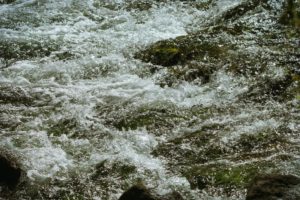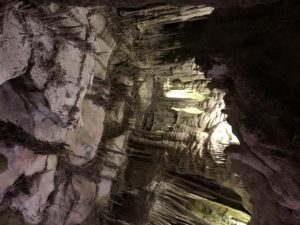This is a topic that belongs in every category. Be in traveling by car, SUV pulling a camper, motor home or even hitchhiking, you need to remain properly hydrated. When camping, backpacking, exploring or in the back county in general, it is even more important. There are two ways to have enough water with you: pack it in – or – purify it as you go.
It should be noted that if you are hiking in the arid southwest or any area with little rainfall or limited fresh water streams/rivers/lakes, you will need to plan accordingly. When getting water from a freshwater source, look for a fast running stream with the water rushing and bouncing over rocks.

The action of the churning of the water passing over the rock will help clean and reduce – but not eliminate – some minerals, contaminates and microorganisms. This water will still need to be boiled, filtered or treated with water purification tables or some combination of the three before being consumed or cooked with.
Additionally, do not drink salt water with out processes (mostly distillation) to remove the salt. It will actually be counter productive to do so. The salt you consume when drinking salt water causes your body to need more water then you drank. It becomes a dangerous and deadly game of you drinking salt water, it makes you want to drink more and you keep drinking until you are bloated and risking congestive heart failure.
I am going to break this into three sections: (1) Water bottles/containers; (2) Water filters and (3) Water purification tablets.
(1) Water bottles/containers
(2) Water filters
((Physical filtration provides a physical barrier that removes larger particles from your water. Chemical filtration uses simple chemical reactions on water passing through an activated material (like carbon) to remove smaller impurities that physical filters can’t catch.))
((Generally speaking, a water filter is designed to remove waterborne protozoa and bacteria, but not viruses. A water purifier is designed to remove protozoa, bacteria and viruses, offering a higher level of defense.))
(((What’s the difference between a backpacking water filter and water purifier?
Put simply, the main difference lies in the level of protection these two treatment devices provide against the harmful microorganisms that may be lurking in backcountry water sources. Generally speaking, a water filter is designed to remove waterborne protozoa and bacteria, but not viruses. A water purifier is designed to remove protozoa, bacteria and viruses, offering a higher level of defense.
Why the two treatment device options?
Traditionally, tackling viruses has been tough for water treatment devices. On the microscopic scale, viruses are far smaller than protozoa and bacteria. Because of this, they’re too small for backpacking filters to catch; they simply slip through the filter media that filters use.
Until recently, UV light, chemical treatments or boiling your water were required to deactivate viruses by scrambling their DNA. Now, however, advancements in mechanical pump purifiers mean you have a convenient way to physically remove viruses along with bacteria and protozoa, all in one easy step.
While pump purifiers and other purifying agents are great when you need them, a purifier isn’t always considered necessary on every trip. Let’s take a look at why.)))
(3) Water purification tablets
((Iodine water purification tablets are really only effective against viruses and bacteria, and more appropriate as a second stage purification method to kill viruses after removing giardia and cryptosporidium with a water filter.))
((tablets are based on chlorine dioxide, one of the strongest antiseptics for water purification, which can kill viruses, bacteria, cysts, and protozoa such as giardia and cryptosporidium.))
((Chlorine dioxide is an oxidant. This means that chlorine dioxide removes electrons from another compound during a chemical reaction. … Chlorine dioxide is considered potentially toxic to humans at concentrations higher than 0.8 mg/L))
((Water purification tablets have become a popular choice for on-the-go disinfection thanks to their portability and simplicity: just filter cloudy/turbid water through a filter or cloth, drop a tablet in 1-2 liters of water, wait 30 minutes and it’s safe to rehydrate.))
Pictures below are provided by contributors or supporters of this website. If you are interested in sharing your pictures of Nevada, please drop us a note.

Courtesy S. Ward – Inside Lehman Caves